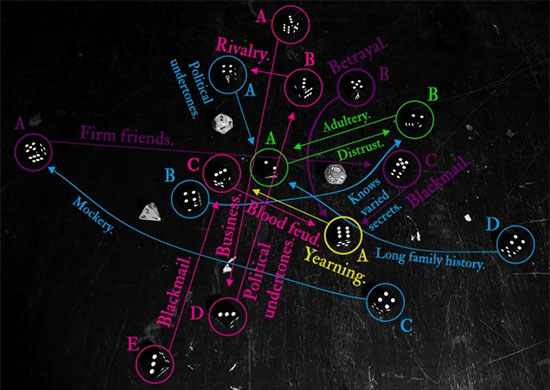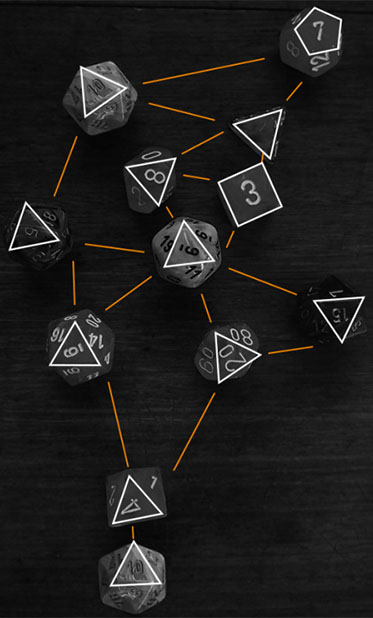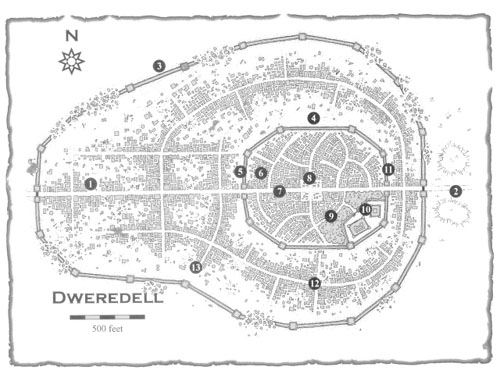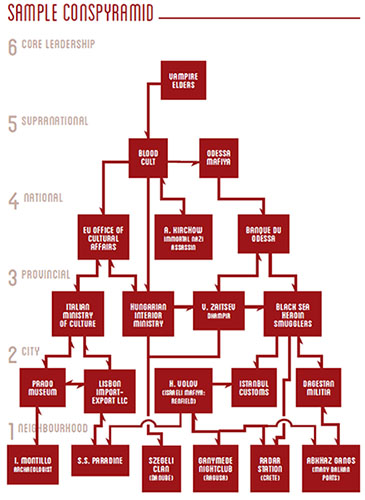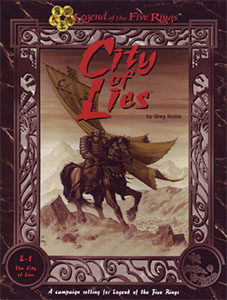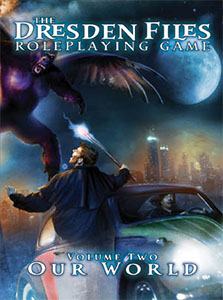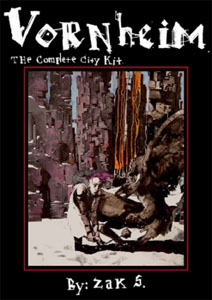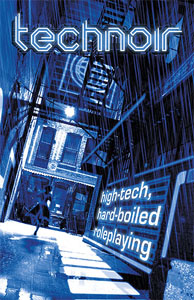Now we have a basic framework for the urbancrawl: A map divided into districts. Content keyed to each district.
What we need now is a default action that will allow the PCs to engage with that keyed content. In dungeoncrawls and hexcrawls, that action is geographic movement. In the urbancrawl, it’s the investigation action.
In my discussion of hexcrawls, I advocated for the “hidden hex”: The hex is an abstraction that’s useful to the GM for keying and managing content, but which has no meaning for the PCs. In the urbancrawl, however, I believe that you will generally be keying content to districts that are meaningful to the PCs: They know where that ward or neighborhood or landmark or street is located.
So the basic investigation action ends up being pretty simple and very transparent: The player points to a neighborhood and says, “I want to investigate there.” The GM looks at their key and tells them what they’ve found. (If the GM is using multiple urbancrawl layers, then they can randomize which layer has been discovered with this investigation action.)
GENERIC vs. SPECIFIC INVESTIGATION
In actual practice, though, you’re quickly going to want to add additional utility to this basic action.
The first thing you’ll need is the ability to distinguish between generic investigations and specific investigations.
In a generic investigation, the PCs are just looking for anything interesting without any particular agenda. This generic investigation is identical to our basic interaction above.
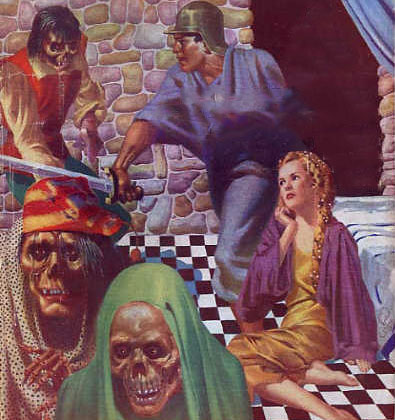 In a specific investigation, on the other hand, the PCs are poking around with a particular goal in mind. This is where the urbancrawl layers become significant: They’re not just looking for anything of interest, they’re specifically looking for a patron. So instead of randomly selecting content from your available layers, you’ll key the specific content tied to the patron level of your urbancrawl.
In a specific investigation, on the other hand, the PCs are poking around with a particular goal in mind. This is where the urbancrawl layers become significant: They’re not just looking for anything of interest, they’re specifically looking for a patron. So instead of randomly selecting content from your available layers, you’ll key the specific content tied to the patron level of your urbancrawl.
(You might also include a chance of them finding something other than what they were looking for. For example, you might roll 1d6 and on a roll of 1 they get information from an urbancrawl layer other than the one they intended.)
I’ll also argue that this is the point where you should start hiding the abstraction again: You’ve arranged the content of your city into urbancrawl layers because that’s a convenient way of organizing it and interacting with it as a GM, but those layers don’t really have “meaning” in the game world. The players shouldn’t be saying things like, “I’d like some content from the Heist urbancrawl layer, please.” You want them to be saying, “We need another big score real bad. I’m going to go hit up my contacts in Oldtown and see if I can find something lucrative.”
(At that point you might look at your key and note not only the Tablets of Shandrala that are being held by the local Sheriff of Taxes (as keyed to the Heist layer of your urbancrawl), but also that Count Ormu on the Vampire layer of your urbancrawl in the same district holds the onyx crown jewels of the Lich Queen of Rasang.)
At this point, you might also be thinking about prepping a random table for selecting specific districts if the PCs attempt city-wide investigations. That’s certainly an option and I’m not going to say thee nay, but I suspect you’ll lose some feeling of the ‘crawl if you do that: Instead of crawling to a specific part of town and poking around (exploring the town and everything it has to offer as they do so), the players are just kind of generically asking for a content handout.
(For similar reasons, I wouldn’t run a dungeoncrawl by randomizing which room they explored next. This is why I think making the district structure of the urbancrawl explicit is the right way to go: It encourages that specific engagement with the geography of the city and requires that meaningful exploration choices are being made. On the other hand, I could certainly be completely wrong about this.)
MECHANICS OF THE INVESTIGATION ACTION
Instead of having the investigation action result in an automatic success, you might want to resolve it mechanically. Obviously the exact nature of the mechanic will depend on the system you’re using, but for the sake of argument let’s assume we’re using D&D 3.5.
 The most obvious mechanic here would be a Gather Information check. You could set a universal DC for the check (DC 15 to perform an urbancrawl investigation); or you could vary it by city (DC 15 in the City-State of the Invincible Overlord, but DC 20 in the more tight-lipped City-State of the World Emperor); or you could vary it by urbancrawl layer (DC 10 for the Random Encounter layer, DC 20 for the Vampire layer); or you could define it for each key entry (DC 15 to find the blood den in Midtown, but DC 22 to find the den in the Nobles’ Quarter).
The most obvious mechanic here would be a Gather Information check. You could set a universal DC for the check (DC 15 to perform an urbancrawl investigation); or you could vary it by city (DC 15 in the City-State of the Invincible Overlord, but DC 20 in the more tight-lipped City-State of the World Emperor); or you could vary it by urbancrawl layer (DC 10 for the Random Encounter layer, DC 20 for the Vampire layer); or you could define it for each key entry (DC 15 to find the blood den in Midtown, but DC 22 to find the den in the Nobles’ Quarter).
You could also allow for exceptional successes to generate additional information. If you were using a One Roll Engine system like Better Angels or Reign, for example, you might generate “soft rumors” for each additional set after the first. These soft rumors wouldn’t give the PCs a specific hook, but they would tell them about general areas of interest that are available in the local urbancrawl. (For example, you might tell them about rumors circulating through the Temple District about people showing up with puncture marks on their necks. They won’t find a specific blood den that way, but it might prompt them to go looking for it.)
You could similarly use the height of an ORE set to determine if the PCs get additional pieces of actionable intelligence. For example, any simple success tells them where the vampire blood den is. But if they score additional dice in the set you might tell them how many vampires are nesting there or give them a floorplan. (This could also just translate into additional rolls on an old school rumor table about the location.)
CONTEXTUALIZING
Starting off with generic Gather Information checks is probably a good starting point, but I’m guessing it won’t take long for the PCs to start attempting investigatory actions that would be handled better through alternative skill checks.
If we think back to our survey of old school city supplements, we might recall that Pavis had some interesting guidelines for PCs researching information in the city.
Gather Information checks can be used to handle the collection of gossips and rumors from taverns and markets.
Knowledge skills could be used when searching through records and the like. Pavis suggests the records of cults and guilds (diaries, receipts, letters, ledgers). It might also represent tax records or newssheets or libraries or any number of other things depending on the particular setting. Gaining access to these records might require Bluff, Diplomacy, and/or the paying of a fee or bribe.
Knowledge (Local) could be used to generate “soft rumors” like the ones discussed above (suggesting potential avenues of investigation).
Specific types of urbancrawl layers might also suggest other skills. For example, maybe an Appraise check would make the best fit for the hypothetical Heist layer I keep using for examples. Players are also likely to suggest all kinds of specific hijinks that could trigger other skill checks (like a Forgery check to gain access to property records or a Decipher Script check to figure out the graffiti patterns the local gangs are using).
The point here is that, like any action resolution, you want to contextualize the investigation action and you also want to respond to the contextualization provided by your players: Don’t just tell them “the vampire den is on Highborn Street”, tell them how they learned that piece of information.
A good technique for this is to make the skill check and then (assuming success) frame the scene just before the information is acquired. For example, if they make a Gather Information check to figure out where Don Carlo is holed up don’t just tell them, “You talk to Don Carlo’s driver and he tells you that he’s got safehouse on the east side.” Instead, cut to the point where they walk into a seedy bar and find the driver half drunk. That lets you play through the moment, which can set the mood, allow for memorable roleplaying opportunities, or lead the investigation in unexpected directions.

